
Since 2009, investing has been relatively easy. This is not to say that we didn’t have any bumps along the way, but the general trend carried many things higher. This also allowed people the opportunity to forget just how painful these bear markets can be. This year is setting the record straight. We’ve once again been reminded what volatility can look like and for anyone who is trying to find logic in short term market movement, you’ve been reminded that there likely isn’t any. In case you’re wondering, here’s the volatility I am referring to:
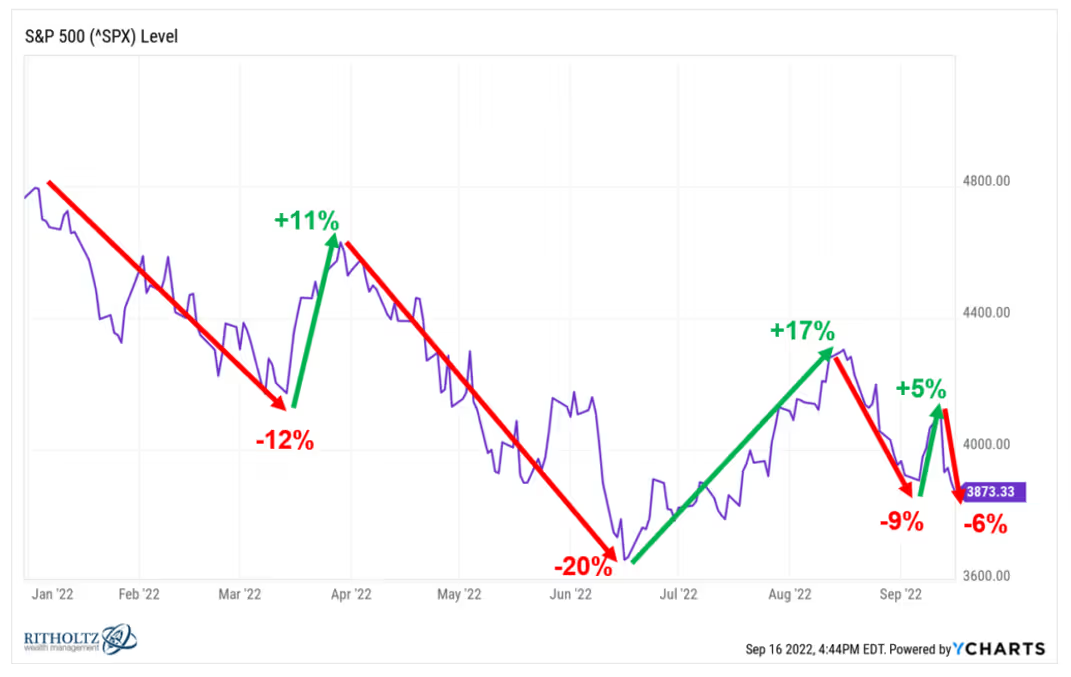
So far, September has been a month to forget in the markets as well. The main reason is that uncertainty remains around just how high-interest rates will climb. This became evident in the last couple of weeks as core inflation in the US didn’t come down as much as expected, followed by a 0.75% rate high announced by US Federal Reserve Chairman, Jerome Powell, which despite being largely expected, sent stock markets into sell off again last week. One of the questions I have received regularly throughout this market is:
“Are things different this time? Is there any precedent for what we are experiencing?”
The short answer is, so far this has been quite a typical bear market. At the time of writing this, the S&P 500 is down over 23% on the year and the Nasdaq composite index is down about 31%. To put these figures into perspective, here is a breakdown of each bear market experienced since WWII:

Note: I am illustrating using US market data since it is the most broad stock market in the world and in my opinion more indicative of the global economy
What this data shows us is that from a market drawdown perspective, the pullback we have seen is quite typical, and not as steep as most other bear markets, at least not yet. What this tells us is that despite the despair and pain that people are feeling, this market could continue to fall from here, or it might not, but what is clear is that if you are going to have investments in the stock market this is something that you need to become accustomed to. Speaking of pain and despair, how is the general investing public feeling these days?
According to the American Association of Individual Investors, people are not feeling that good at all. In fact, as of the end of September 21st, almost 61% of investors were feeling bearish, or negative about where stocks will be in the next 6 months. To put that into perspective, people haven’t been this negative about the future of the markets since the financial crisis. This is the third most extreme bearish reading in history. The good news, typically markets go on to have above-average returns following these extreme indications of negative sentiment, meaning that this level of negativity might actually be a good thing going forward.

Source:https://www.aaii.com/sentimentsurvey
As I said earlier, this year is setting the record straight on just how difficult it can be to be a successful investor. Markets like this are like a predator. They test your fortitude and your discipline. They wear you down until you have no willpower left. They force you to question everything you thought to believe was true. Ultimately, they force most people into making bad decisions. As the great Warren Buffett likes to say, “The stock market is a device for transferring money from the impatient to the patient.”
These are the times when successful investors shine. This is when I think it’s important to get back to the basics of investing as well. Part of getting back to the basics is reminding ourselves what we are actually investing in because that is easy to lose sight of when we just look at numbers on a screen or a statement. We need to remind ourselves that we are in actuality investing in good assets and in the case of the stock market, we are investing in businesses. These businesses overall, are far less volatile than what the stock market might have you believe as well. Since 1988, dividends per share in global stocks have risen at a rate of 6% per year on average. Additionally, earnings per share have risen at 7% per year during that same time frame. Being a good investor sometimes means that you need to ignore the short-term noise and get back to the fundamental basics that if you are buying good assets with strong and consistent growth prospects, and if you’re not overpaying for them, in time you will be rewarded.
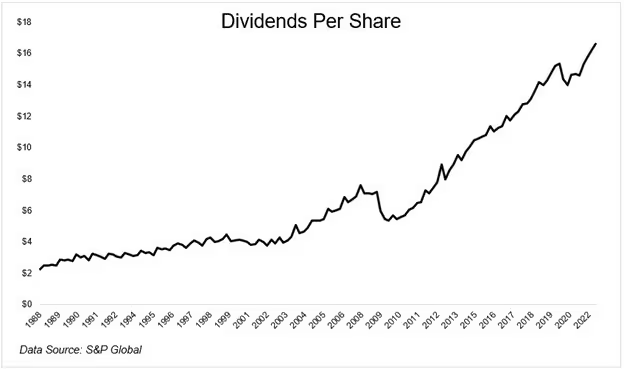
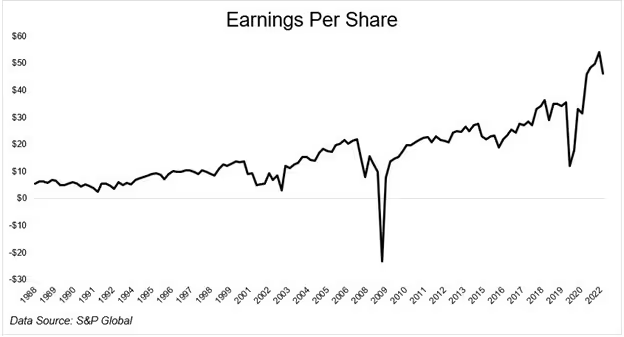
So, what is the biggest question on everyone’s mind? When will we see a recovery of course! Without the crystal ball, we must look to history to be our guide. The reason for every bear market may be a little different, but the impacts, the experience and the recovery of those markets tend to be very typical. Following the sell-off last week, after seeing hotter-than-expected inflation numbers from the US, the S&P 500 sold off 4.3% in a single day, which was the worst single-day return since June of 2020. On that day, less than 1% of companies on the index finished in positive territory. This is the 20th time since 2000 that this has occurred, but only twice were markets down still after 12 months following that day and in fact, markets tend to rise significantly higher following that point, seeing on average increases of 19.1%. The NASDAQ also finished significantly lower that same day with 100% of stocks being down on the tech-heavy index which has happened 13 other times in history. In the following 12 months after these occurrences, the NASDAQ climbed 100% of the time with an average increase of 21.2%! (https://awealthofcommonsense.com/)
Looking at the markets a little more broadly, on average, one year after entering into a bear market (a market that has declined by 20% or more from peak to trough) markets return 23.9% over the next 12 months.
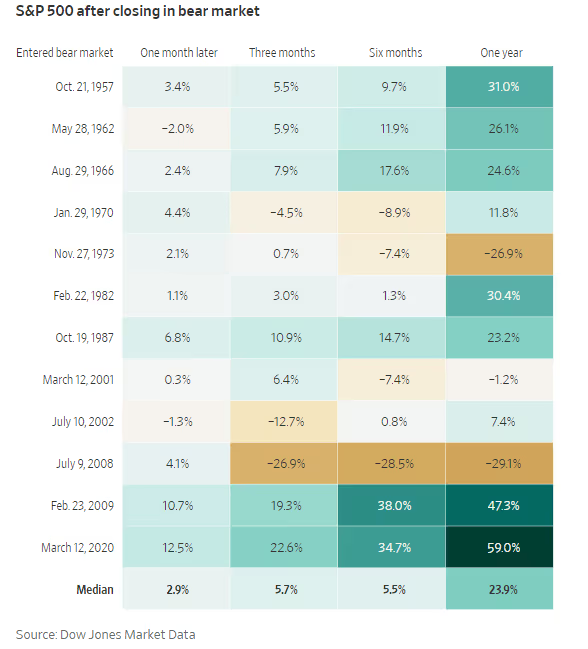
Recovery markets also tend to last significantly longer than downward bear markets, about 5 times longer to be exact and also tend to rise significantly higher. The average bear market lasted about 14 months while the average recovery on the other side tend to last 72 months. The average market decline as pointed out above tends to bring things back about 33%, while the average recovery has shown to produce increases of 279% from the bottom.
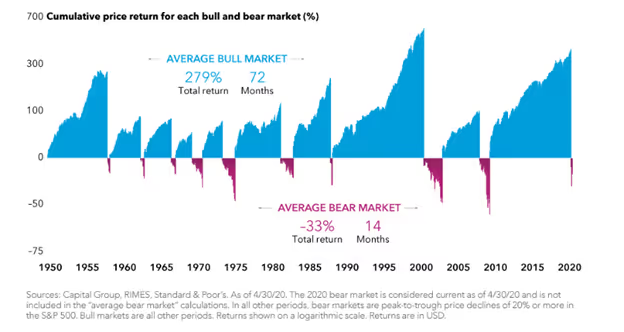
So, we know that if history is our guide, we likely have a nice market return coming, perhaps even over the next 12 months. But can we avoid the pain we are facing today? Unfortunately not, or at least not if we want to be a successful investor going forward and for the long term. I mentioned that markets like this are predatory. They want to chase you down and force you into making bad decisions. The most common mistake investors make is to sell to cash and wait until the market starts to recover before buying back in. Investors feel like they can try and time the market, or at least get most of it right. The thought is, it’s ok to miss out on the beginning of the recovery, “I’ll buy back in after things start to improve and I will get most of the upside over the next 72 months.” Unfortunately, it doesn’t work that way because the best market returns often happen early in the recovery and even missing the first few days could cost you years worth of returns in the long run. Consider an example of a hypothetical investor who sold out of the market during the financial crisis of 2008-2009 and attempted to time the market and jump back in. Unfortunately, what history shows us is that even missing just the 10 best days over 10 years would cut your returns almost in half. Missing 20 or more days means that your returns are either anemic or could even be negative over that period.
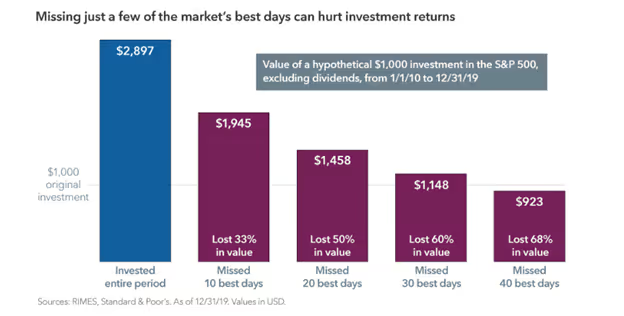
Well, that depends on you. If you are in the accumulation phase of your life, then this market should absolutely be looked at as an opportunity. I’m reminded of a quote by Morgan Housel “All past declines look like opportunity. All future declines look like risk.” For you, this is the best investment opportunity that has been seen likely since the financial crisis.
If you are in the stage of life where you have already accumulated assets, and maybe you are living off of them, then you have benefitted by the markets over the last decade. The key now is staying disciplined to your financial plan and your portfolio strategy. Markets like this tend to be short-term in nature and it’s critically important that you remain invested so that you experience the recovery. Making changes to alleviate short-term pain may make you feel better now, but as history has shown us, it will likely hurt you in the long term. Activity for the sake of activity is simply giving you a false sense of control. Sometimes the best action you can take is the action of sticking to your plan and process.
Bear markets are painful. There is no doubt about it. They always have been and they always will be. What is most important is that we cannot let that pain make our investment decisions for us. That’s when short term pain becomes long term problems and missed opportunities.
- Grant White, CIM®,CFP®
Grant White is a Portfolio Manager/Investment Advisor at Endeavour Wealth Management with iA Private Wealth Inc, an award-winning office as recognized by the Carson Group. Together with his partners he provides comprehensive wealth management planning for business owners, professionals and individual families. This information has been prepared by Grant White who is a Portfolio Manager for iA Private Wealth Inc. and does not necessarily reflect the opinion of iA Private Wealth.
The information contained in this newsletter comes from sources we believe reliable, but we cannot guarantee its accuracy or reliability. The opinions expressed are based on an analysis and interpretation dating from the date of publication and are subject to change without notice. Furthermore, they do not constitute an offer or solicitation to buy or sell any of the securities mentioned. The information contained here in may not apply to all types of investors. The Portfolio Manager can open accounts only in the provinces in which they are registered.
If you felt a little uneasy at times this year, you weren't alone. It was a year characterized by mixed signals, economic data that defied expectation
December 29, 2025
Imagine you’re starting a road trip alone. You’ve got a full tank of gas, the music is on, the destination is… well, undefined. You could head toward
December 22, 2025
One of the core promises of index investing is diversification: own the market, spread your risk, and avoid reliance on any single company or sector.
December 15, 2025
Download your free guide to financial freedom.
Download your free guide to learn how you can protect your retirement savings with a Personal Pension Plan.
Download your free guide to help ensure you don’t run out of money.
Download your free guide to learn how to ensure your portfolio and plan stay on track.